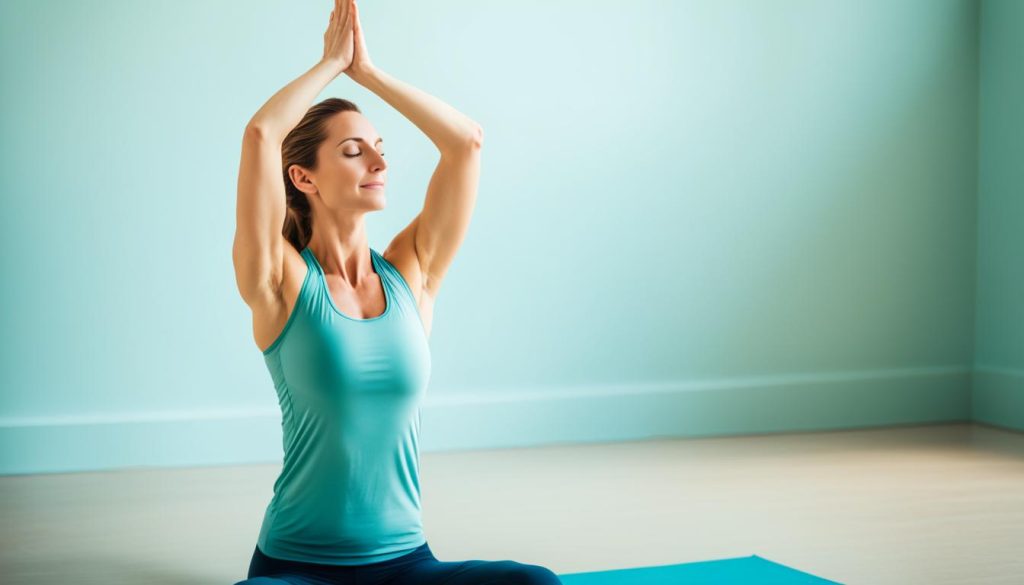Elevate your shoulder workout with targeted trapezius exercises for improved strength, posture, and muscle hypertrophy. In this article, we will explore the anatomy and importance of the trapezius muscle, how to activate it, core exercises for comprehensive shoulder workouts, advanced techniques for muscle growth, stretches for flexibility and pain relief, balancing intensity and frequency in trapezius training, recovery techniques and injury prevention, and conclude with the benefits of incorporating trapezius exercises into your fitness routine.
Anatomy and Importance of the Trapezius Muscle
The trapezius muscle is a vital component of the upper body’s musculature. It runs from the base of the neck to the middle of the back, resembling a trapezoid shape, hence its name. This large muscle plays a crucial role in various functions related to upper body strength and posture.
Understanding the Trapezius Muscle Structure
The trapezius muscle is divided into three distinct regions: the upper trapezius, middle trapezius, and lower trapezius. Each section has its own responsibility in enabling movement and stability in the upper body.
The upper trapezius connects the neck and upper thoracic spine to the shoulder blade. It primarily facilitates movements such as shrugging and elevating the shoulders. The middle trapezius spans between the shoulders and is involved in retracting the scapulae. Lastly, the lower trapezius connects the shoulder blade to the lower thoracic spine, assisting in the stabilization and downward rotation of the scapulae.
The Role of the Trapezius in Upper Body Strength and Posture
The trapezius muscle is crucial for stabilizing the shoulders and supporting upper body strength during various movements. It aids in maintaining proper posture by counteracting the effects of gravity on the upper body, allowing for optimal alignment of the spine, neck, and shoulders.
By strengthening the trapezius muscle, individuals can enhance their overall upper body strength, effectively distribute loads during exercises, and reduce the risk of imbalances and injuries. Additionally, a well-developed trapezius muscle contributes to an aesthetically pleasing physique, particularly in the upper back and shoulder regions.
Understanding the anatomy and importance of the trapezius muscle is crucial for anyone seeking to improve their upper body strength and posture. With proper knowledge of its structure and function, individuals can implement targeted trapezius exercises to optimize their fitness and wellbeing.
Starting with Trapezius Muscle Activation
Before diving into specific trapezius exercises, it’s important to activate the muscle to ensure proper engagement during your workout. Proper trapezius muscle activation helps to maximize the effectiveness of your shoulder exercises and upper back exercises.
One effective technique for trapezius muscle activation is performing shoulder rolls. Begin by standing up straight with your arms relaxed at your sides. Then, gently roll your shoulders forward in a circular motion for 10-15 repetitions. This movement helps to warm up and activate the trapezius muscle.
In addition, incorporating shoulder exercises that target the trapezius muscle can also aid in activation. Some effective shoulder exercises for trapezius muscle activation include:
- Overhead presses: Hold a pair of dumbbells or a barbell at shoulder height, then raise it overhead in a controlled motion, focusing on contracting the trapezius muscle as you lift.
- Arnold presses: Similar to overhead presses, but with a rotational movement. Start with the dumbbells at shoulder height, palms facing you. As you press the weights overhead, rotate your palms away from you.
- Lateral raises: Stand with your feet shoulder-width apart, holding a pair of dumbbells by your sides. Lift the weights out to the sides until they reach shoulder level, concentrating on engaging the trapezius muscles throughout the movement.
Integrating these shoulder exercises into your workout routine will help to activate the trapezius muscle and prepare it for the following trapezius exercises. Remember to focus on proper form and maintain control throughout each exercise to ensure optimal trapezius muscle activation.

Core Trapezius Exercises for a Comprehensive Shoulder Workout
To build a strong and well-rounded shoulder workout, incorporating core trapezius exercises is essential. These exercises specifically target the trapezius muscle, helping you develop strength and hypertrophy in your trapezius muscles.
One effective exercise to include in your routine is the shrug. This exercise involves lifting the shoulders up towards the ears, holding for a moment, and then slowly lowering them back down. It’s a simple yet highly effective movement that engages the trapezius muscles.
Another great exercise for the trapezius is the barbell deadlift. This compound movement not only targets the lower back and hamstrings but also activates the trapezius muscles. It involves lifting a loaded barbell from the ground to the hips while maintaining a neutral spine.
Incorporating rack pulls into your shoulder workout can also be beneficial. This exercise focuses on the upper portion of the trapezius muscle. It involves setting up a barbell on a rack at knee height and lifting it as high as possible while maintaining proper form.
Upright rows are another effective trapezius exercise. This movement involves pulling a barbell or dumbbells up towards the chin, engaging the trapezius muscles along with the deltoids and biceps.
Lastly, face pulls are a great exercise to target the rear delts and upper back, including the trapezius muscles. This exercise can be done using a cable machine and involves pulling the rope towards your face while retracting the shoulder blades.
Incorporating these core trapezius exercises into your shoulder workout will help you develop strong and well-defined trapezius muscles while ensuring a comprehensive workout for your shoulders.
Advanced Techniques for Trapezius Muscle Hypertrophy
If you’re aiming to enhance muscle growth in your trapezius muscles, there are several advanced techniques you can incorporate into your training routine. These techniques will help you target specific areas of the trapezius for enhanced hypertrophy.
Incorporating Variations for Enhanced Muscle Growth
One effective way to stimulate muscle growth in the trapezius is by incorporating variations of exercises. By using different grips or angles, you can specifically target different regions of the trapezius, leading to enhanced muscle growth. For example, instead of the traditional Overhead Barbell Press, you can try using a Dumbbell Arnold Press. This variation not only engages the trapezius but also activates the deltoids and the triceps.
Another variation you can try is the Sumo Deadlift High Pull. This compound movement targets not only the trapezius but also the hamstrings, glutes, and quadriceps, allowing for a more comprehensive workout and increased muscle growth.
Combining Compound and Isolation Movements
To further stimulate muscle hypertrophy in the trapezius, it’s beneficial to combine compound movements with isolation movements. Compound movements, such as the Bent-Over Row or the Power Clean, engage multiple muscle groups simultaneously, including the trapezius. These exercises allow you to lift heavier weights and increase overall muscle mass.
In contrast, isolation movements, like the Face Pull or the Reverse Fly, specifically target the trapezius, allowing for better muscle activation and hypertrophy. By incorporating both compound and isolation movements into your training routine, you can maximize the growth potential of your trapezius muscles.
Remember to consult with a fitness professional or trainer before attempting advanced techniques to ensure proper form and technique.

Trapezius Stretches for Flexibility and Pain Relief
The trapezius muscles play a crucial role in our overall posture and upper body strength. To maintain their flexibility, relieve muscle tension, and prevent injuries, incorporating regular stretching into your fitness routine is essential. Trapezius stretches not only provide pain relief but also improve range of motion and reduce muscle soreness.
Regular stretching is beneficial for the trapezius as it helps elongate and relax the muscles, improving their flexibility. Increased flexibility allows for better movement and prevents muscle imbalances that can lead to pain and injury. By incorporating trapezius stretches into your exercise routine, you can experience enhanced performance and overall well-being.
Benefits of Regular Stretching for the Trapezius
Regular stretching of the trapezius muscles offers various benefits:
- Promotes flexibility and range of motion in the upper back and shoulders
- Relieves muscle tension and stiffness
- Enhances blood circulation and nutrient delivery to the muscles
- Improves posture and body alignment
- Reduces the risk of muscle strains and injuries
By regularly incorporating trapezius stretches into your fitness routine, you can enjoy these benefits and optimize your overall performance.
Guidelines for Safe and Effective Trapezius Stretching
To ensure safe and effective trapezius stretching, follow these guidelines:
- Start with a warm-up: Before stretching, perform a brief warm-up to increase blood flow to the muscles and prepare them for stretching.
- Focus on proper form: Maintain proper posture and alignment during each stretch to avoid straining other muscles or joints.
- Hold each stretch for 20-30 seconds: Hold each stretch for an adequate duration to allow the muscles to relax and lengthen.
- Avoid bouncing or jerking movements: Perform each stretch in a controlled and fluid motion, without any sudden or jerky movements.
- Breathe deeply and relax: Focus on deep, slow breaths during stretching to promote relaxation and enhance the effectiveness of the stretch.
- Consult a professional: If you are unsure about proper stretching techniques or have any pre-existing medical conditions, consult a fitness professional or healthcare provider for guidance.
By following these guidelines, you can safely and effectively incorporate trapezius stretches into your fitness routine, maximizing their benefits and preventing injuries.

Trapezius Exercises
When it comes to trapezius exercises, finding the right balance of intensity and frequency is crucial for optimal results. Let’s explore how you can effectively incorporate these exercises into your training routine.
Balancing Intensity and Frequency in Trapezius Training
The intensity of your trapezius workouts is determined by the level of effort and resistance you apply. It’s important to challenge your muscles without overexerting them. Start with a weight or resistance that allows you to perform each exercise with proper form and control. Gradually increase the intensity as you become stronger and more comfortable. Remember to listen to your body and adjust the intensity accordingly.
As for frequency, it’s recommended to train your trapezius muscles 2-3 times per week. This allows for adequate recovery between sessions while still providing enough stimulus for growth. Consider alternating trapezius exercises with rest days or focusing on different muscle groups to prevent overtraining.
How to Incorporate Trapezius Exercises into Split Training
Split training involves dividing your workout routine into different muscle groups on separate days. This approach allows for greater focus and specialization. To incorporate trapezius exercises into split training, dedicate a specific training day solely to shoulder and upper back exercises. This way, you can give your trapezius muscles the attention they deserve and work them with proper intensity and focus.
Here’s an example of a split training routine:
- Day 1: Chest and Triceps
- Day 2: Back and Biceps
- Day 3: Legs
- Day 4: Shoulders and Trapezius
- Day 5: Rest
- Day 6: Repeat the cycle
By incorporating trapezius exercises into your split training routine, you can ensure that your trapezius muscles receive sufficient attention and stimulation for growth and strength development.

Remember, it’s important to consult with a fitness professional or trainer to ensure that your training program suits your individual needs and goals. They can provide personalized guidance on intensity, frequency, and exercise selection to help you achieve the best possible results for your trapezius muscles.
Trapezius Muscle Care: Recovery and Injury Prevention
When it comes to training the trapezius muscles, prioritizing recovery and injury prevention is crucial. Proper care and attention can help you avoid trapezius strain and overuse injuries, allowing you to train effectively and achieve your fitness goals. In this section, we will explore post-workout recovery techniques specifically for the trapezius, as well as help you understand the signs of trapezius strain and overuse.
Post-Workout Recovery Techniques for the Trapezius
After an intense trapezius workout, it is important to implement effective recovery techniques for optimal muscle repair and growth. Here are some key strategies:
- Stretching: Perform gentle stretches for the trapezius muscles to alleviate tension and improve flexibility. Focus on elongating the muscle fibers for enhanced recovery.
- Foam Rolling: Utilize a foam roller to massage and release tension in the trapezius muscles. This self-myofascial release technique can promote blood flow and reduce muscle soreness.
- Proper Nutrition: Fuel your body with a well-balanced diet that includes sufficient protein, carbohydrates, and healthy fats. Adequate nutrition supports muscle recovery and growth.
By incorporating these post-workout recovery techniques into your routine, you can enhance trapezius muscle care and promote optimal muscle repair.
Understanding Signs of Trapezius Strain and Overuse
It is essential to be aware of the signs of trapezius strain and overuse to prevent long-term damage and potential injuries. Here are some indications that you may be experiencing trapezius strain or overuse:
- Persistent and sharp pain in the trapezius area.
- Restricted range of motion in the shoulders and neck.
- Tenderness or swelling in the trapezius muscles.
- Reduced strength and performance during trapezius exercises.
If you experience any of these symptoms, it is important to rest and allow your trapezius muscles to recover. Continuing to train with trapezius strain or overuse can worsen the condition and potentially lead to more severe injuries. If the symptoms persist or intensify, consult a healthcare professional for proper diagnosis and treatment.
By taking proactive measures to prioritize trapezius muscle care, recovery, and injury prevention, you can ensure the longevity of your fitness journey and maintain healthy and strong trapezius muscles.
Conclusion
Incorporating trapezius exercises into your shoulder workouts is essential for building stronger and more effective shoulders. Whether you’re aiming for improved strength, better posture, or muscle hypertrophy, the exercises and techniques covered in this article will guide you towards achieving your goals.
Elevate your shoulder workout with targeted trapezius exercises and experience the benefits for yourself. By regularly engaging and strengthening the trapezius muscles, you can enhance your overall upper body strength and stability, leading to better performance in various activities and sports.
Don’t underestimate the impact of a well-developed trapezius muscle. Strengthening this crucial muscle group not only improves your shoulder’s functional capabilities but also contributes to a more aesthetically pleasing physique. So, why wait? Start incorporating trapezius exercises into your shoulder workout routine today and take your fitness journey to new heights!
FAQs
What are trapezius exercises?
Trapezius exercises are specific exercises that target the trapezius muscle, which is a large muscle that extends from the base of the neck to the middle of the back. These exercises help strengthen the trapezius muscle, improve posture, and enhance overall shoulder workout effectiveness.
How do trapezius exercises strengthen the trapezius muscle?
Trapezius exercises involve movements that actively engage and activate the trapezius muscles. By performing these exercises regularly and with proper form, the trapezius muscles are gradually strengthened and hypertrophied, leading to improved strength, endurance, and overall shoulder function.
What are some examples of upper back exercises that target the trapezius?
Examples of upper back exercises that target the trapezius muscle include shrugs, barbell deadlifts, rack pulls, upright rows, and face pulls. These exercises engage and activate the trapezius muscles, helping to build strength and develop muscle hypertrophy in the upper back and shoulders.

